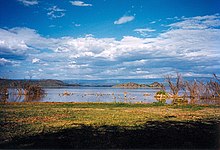Perkerra River
| Perkerra River | |
|---|---|

|
|

Mau Forest (center, green). Perkerra is the western river flowing from the forest to Lake Baringo to the northeast. Molo River is the eastern river.
|
|
| Country | Kenya |
| Basin features | |
| Main source | 2,400 metres (7,900 ft) |
| River mouth | 980 metres (3,220 ft) 0°32′05″N 36°05′33″E / 0.534632°N 36.092491°ECoordinates: 0°32′05″N 36°05′33″E / 0.534632°N 36.092491°E |
| Basin size | 1,207 square kilometres (466 sq mi) |
The Perkerra River is a river in the Great Rift Valley in Kenya that feeds the freshwater Lake Baringo. It is the only perennial river in the arid and semi-arid lands of the Baringo County. The Perkerra river supplies water to the Perkerra Irrigation Scheme in the Jemps flats near Marigat Township, just south of the lake.
The river has a catchment area of 1,207 square kilometres (466 sq mi). It rises in the Mau Forest on the western wall of the Rift valley at 8,000 feet (2,400 m), dropping down to 3,200 feet (980 m) at its mouth on the lake. The catchment area has steep slopes on the hillsides, flattening out lower down. Most of the water comes from the hill slopes, where annual rainfall is from 1,100 millimetres (43 in) to 2,700 millimetres (110 in). The region around the lake is semi-arid, with annual rainfall of 450 millimetres (18 in) and annual evaporation rates of 1,650 millimetres (65 in) to 2,300 millimetres (91 in).
In the late 1800s the alluvial plains near the lake were occupied by the Njemps people, an ethnic group related to the Maasai. They used a brushwood barrier to raise the level of the river and let the water flow over the flat ground. The barrier would be destroyed by the seasonal floods, needing to be replaced, but the system was stable. The British explorer Joseph Thomson visited the Perkerra in the nineteenth century with his caravan and bought grain from the local people, grown using their proven system of irrigation using basins and canals.
With the advent of Europeans in the area, both human and livestick populations increased. The high grass of the catchment was grazed down, erosion increased and run-off rates also increased, causing periodic floods. The brushwood barrier system could not deal with the floods and the Njemps turned to pastoralism. Severe overgrazing, drought and locust invasions led to a food crisis in the late 1920s. In the 1930s the colonial administration began considering the possibility of irrigation, and a formal study was made in 1936, although nothing was done for some years.
The Perkerra irrigation scheme was launched in 1952 during the Emergency. Construction began in 1954.> Detainees made the roads and prepared the land for irrigation. The project was rushed, expensive to implement and maintain, with little in return. There were difficulties raising crops and difficulty selling them. Many of the tenant farmers who were settled on the project later left. By 1959 it was decided to close the scheme, which had only 100 families, but this was changed to continuing minimal operations. In 1962 the scheme was expanded, and by 1967 there were 500 farming houses, although subsidies were still needed.
...
Wikipedia
